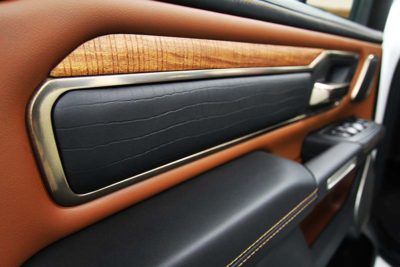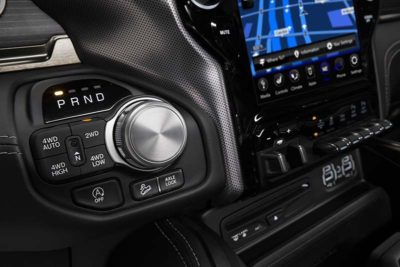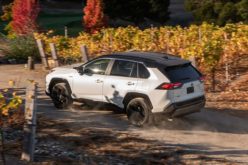Feature: A Designer By Design

How Ryan Nagode is Shaping the Future

I’m sitting in an automotive masterpiece with a guy I first met in a bar. He was drinking a gin and tonic while I mugged a pint of craft-brewed ale. (Don’t go there.)
Ryan has class, I have little. He also knows a thing or two about design, which is obvious from his pointed double-buckle hi-cut black leather shoes and tailored jeans.
I don’t normally notice these things, but I want to this time. Ryan C. Nagode is the chief designer of RAM, SRT, and Fiat interiors. This dude is cool; his obsessively-trimmed 7-day beard makes a statement of perfection where mine simply reflects laziness.
I met Ryan at a reception hosted by Fiat Chrysler Automobiles the night before the 2018 Vancouver Auto Show kicked off and was anxious to connect with him at the show. I wanted to learn more about the role of an interior designer and how he came to be the head honcho for the stunning cabin of the 2019 RAM.
On opening day, we climbed into the RAM Longhorn on display; me in the driver’s perch, Ryan riding shotgun in the FCA-supplied boardroom. Ryan’s been with Fiat Chrysler now for 15 years, joining Chrysler directly out of design school before ascending the ranks to chief interior designer for half of all FCA products – the fun half.
Ryan honed his artistic side at the Cleveland School of Art, but he was breathing design work while other toddlers were chewing crayons thanks to his dad who made a living as a designer at Fisher Price Toys. In fact, friends and family members were either artists or designers of some sort or other.
Heading off to art school, Ryan’s intended path was to lead him into a world of industrial design. That was until a gearhead friend dragged him to a design class for cars, and pretty much from that moment forward it was a one-way road to automotive design.

Good designs don’t happen by accident, and Ryan knows this better than anyone. “It’s a labour of love, that’s for sure,” says Ryan about the time it takes to complete a design project and get everyone onboard and excited.
Designing truck interiors is particularly challenging says Ryan. “You can’t ignore that it’s got to do its job as a truck,” he says. “We did a lot up front with pen to paper on the styling to make everything function, which included lots of breadboard mock-ups exploring space usage and how clever we could be with that.”
To my surprise, Ryan says that they still work with clay to create life-size mock-ups that look and feel real, right down to using genuine stitching in the clay dashboard. One of the tricks in building these models is the use of latex house paints to cover surfaces says Ryan.
The mock-ups, which look very realistic, are kept internal and not sent out to research clinics. (Hmm…the detective in me figures this is done to protect those clever design elements, such as configurable storage cubbies, iPod holders, and passive phone chargers from being pilfered by the competition.)
Ryan talks about the importance of the full-size mock-ups. “You can only do so much in the computer. For a truck, you’ve got to sit behind it, feel it, use it, and make sure that what you’re putting in works.”
I raised with Ryan the issue of distracted driving due to touch-screen interfaces, asking how the industry plans to deal with that.

“I don’t have to touch the screen,” Ryan said, while also mentioning that they use large switchgear to accommodate gloves. This is good I thought, especially for Canadian winters, but what’s in the future for car interiors I asked him.
“You can’t ignore the screens,” he said, pointing to the smaller screen residing between the tachometer and speedometer in the instrument panel. “There are seven zones of information there. You can reconfigure them or clean them out completely if you want less information.”
Configurability of information is what Ryan sees in the future, in which drivers can choose what information is important and where and how it should be displayed.
Ryan rightly points out that top-tier trucks, such as their Longhorn and Limited, are more like SUVs with a box than conventional pickups, and that buyers of these vehicles aren’t necessarily brand loyal.
“They want the latest and greatest technology, and they’ll jump from one to another to get it” remarks Ryan.

A certainty though, is what customers “dislike,” and that’s filtered that out early.
I was curious about what Ryan views as the greatest challenge in the field of automotive interior design.
Any guesses?
As it applies to truck cabs, Ryan was very clear in his answer. It’s the vast range of trim levels in these modern workhorses that suck the life out of a designer.
From base utilitarian models to the rolling living-rooms of the top-tier segment, the broad range of available content, luxury, and decor is difficult to accommodate in a modern cab design.
So, what’s the technique? “Being smart about how we swap things in and out so there’s more of a modular approach to it,” says Ryan. But “smart” from a production perspective doesn’t necessarily translate into “beauty” from a consumer perspective.
Yet in this way, Ryan and his team have hit a homer.
The Longhorn cabin in which we chat is trimmed with appliques of Barn Wood, as the RAM teams calls it. The wood is genuine, thick, and roughly hewn compared to anything else I’ve had the organic joy of running my fingers over in a vehicle.
Each Barn Wood Longhorn cab features an authentic hot-iron branding on the wood adorning the dash, which reads “Longhorn.” No two brandings are exactly the same. Again: new, innovative, unique, and giddy-up cool.
Congrats to Ryan and his team of visionaries. Four and a half years ago they embarked upon a journey that culminated in today’s automotive masterpiece. For Ryan though, that journey began many decades earlier, sparked by a twinkle in his dad’s eye and a Fisher Price toy.























